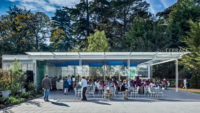San Francisco, California
To support the expansive roof, RPBW designed a set of four masonry structures—one at each corner—incorporating two of the original academy’s Neoclassical limestone walls in the northeast structure and using poured concrete for the others. Although not immediately apparent, memory informs Piano’s modern machine—in the building’s Neoclassical symmetry and its slender, steel hypostyle colonnades on each facade. Inside, the central piazza—partially covered by a “spider’s web” of cables, rods, and glass—recalls the old academy’s central courtyard, while re-creations of the institution’s barrel-vaulted African Hall and Doric-columned Steinhart Arch serve as touchstones for returning visitors.
The public enters the building from the north up a stepped podium, while the academy’s staff and research personnel cross a short bridge over a man-made ravine on the south. (By carving out earth for the ravine, RPBW brought daylight into the building’s two lower floors.) The solar canopy wrapping around the building’s perimeter provides a shaded transition space between indoors and out, in the process converting the sun’s rays into electricity. “It works just like the leaves of a tree,” explains Piano. On the west, an outdoor sculpture by Maya Lin helps tie the building to its park setting; a second piece by Lin—on the east—will open on Earth Day 2009.
In the northeast-corner structure, the architects inserted the rebuilt African Hall along with its original dioramas, and in the northwest one they placed the museum café and store. The southeast and southwest blocks house research and administration spaces, some of which the public can look into and see that the building is more than just a museum. Between the masonry structures on each corner, RPBW created a pair of enormous exhibition halls with the glass-wrapped piazza in the middle. Daylight and air enter from the 35-foot-high glass walls on the east and west, as well as from the piazza.
Anchoring the halls are two 90-foot-diameter spheres: an aluminum-clad one housing the new Morrison Planetarium, and a steel-frame one containing a four-story rain-forest exhibition accessed by a steel ramp fabricated by a company that works mostly on roller coasters. Underneath the central piazza and running up to the edge of each giant sphere, the enormous tanks of the Steinhart Aquarium take visitors into an underwater world filled with sharks, fish, and the largest artificial coral reef in the world. Light from the piazza and circular skylights above provide enough daylight to keep all the water creatures happy (and alive). The New York firm Thinc Design led the exhibition-design team and worked with Urban A&O [record, December 2008, page 80] on the Water Planet exhibit in the aquarium.
“In the past, science museums were kingdoms of darkness,” states Piano. “You would wander from one dark gallery to another, looking for the dinosaurs and then the dioramas.” At the California Academy of Sciences, though, daylight animates the major spaces—changing the visitor experience from one of trekking through the jungles of science to that of surfing the broad seas of knowledge. By necessity, the planetarium and African Hall block out most sunlight; but they’re the exceptions.
In spirit, the academy recalls Cedric Price’s unrealized 1961 design for a Fun Palace in London: a giant glass-and-steel box filled with spaces for all sorts of entertainment activities. While the academy doesn’t have the gantry cranes Price envisioned rearranging prefabricated components and modules inside his palace, its large halls accommodate rotating exhibitions, and its planted roof changes color and character with the seasons. In places, the academy building seems too accommodating and its relationship with the past a bit forced. For example, the freestanding Steinhart Arch doesn’t really feel at home inside its new setting, and a re-created swamp exhibit with its seahorse railing reads as an act of artificial preservation. But the building’s inclusiveness in programming speaks to Piano’s notion of a “soft” machine.
Explaining his reaction to the completed building, Piano says he was most excited when he visited the observation deck on the green roof as the sun was setting. “I was up there with my son and we saw the skylights pop open to let air into the building. It was like watching an animal come alive and breath.”






Post a comment to this article
Report Abusive Comment